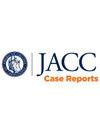Pregnant Patient With Infrarenal Abdominal Aortic Aneurysm Successfully Treated With EVAR
Q4 Medicine
引用次数: 0
Abstract
Background
Pregnancy management in patients with a history of untreated aortic aneurysm or dissection is not established.
Clinical Condition
A patient with a chronic infrarenal abdominal aortic aneurysm and dissection was referred to our hospital at 13 weeks' gestation.
Key Questions
What are the treatment options for infrarenal abdominal aortic aneurysm with dissection in a pregnant patient? What tests are needed for treatment strategy? What are the safety considerations when performing endovascular aneurysm repair (EVAR) during pregnancy?
Outcome
Genetic testing for established hereditary aortopathy genes was negative. After carvedilol treatment, EVAR was performed under ultrasound guidance with minimal radiation exposure at 19 weeks' gestation, allowing for adequate fetal growth. She had an uncomplicated vaginal delivery under epidural anesthesia at 39 weeks' gestation.
Take-Home Messages
EVAR could be an effective treatment option during pregnancy if radiation exposure is properly minimized. Multidisciplinary collaboration, including early evaluation for connective tissue diseases, is essential to evaluate treatment strategy.
妊娠期腹主动脉瘤EVAR治疗成功
背景:未治疗主动脉瘤或夹层病史患者的妊娠管理尚不明确。临床情况一例慢性肾下腹主动脉瘤合并夹层患者于妊娠13周转介至我院。妊娠患者合并夹层的肾下腹主动脉瘤有哪些治疗选择?治疗策略需要哪些测试?妊娠期进行血管内动脉瘤修复(EVAR)有哪些安全考虑?结果:已确定的遗传性主动脉病变基因的基因检测为阴性。卡维地洛治疗后,妊娠19周在超声引导下以最小的辐射暴露进行EVAR,允许胎儿足够的生长。妊娠39周时,她在硬膜外麻醉下顺利阴道分娩。如果适当地减少辐射暴露,evar可能是怀孕期间有效的治疗选择。多学科合作,包括结缔组织疾病的早期评估,对于评估治疗策略至关重要。
本文章由计算机程序翻译,如有差异,请以英文原文为准。
求助全文
约1分钟内获得全文
求助全文
来源期刊

JACC. Case reports
Medicine-Cardiology and Cardiovascular Medicine
CiteScore
1.30
自引率
0.00%
发文量
404
审稿时长
17 weeks
 求助内容:
求助内容: 应助结果提醒方式:
应助结果提醒方式:


